1lumen selects and reviews products personally. We may earn affiliate commissions through our links, which help support our testing.
Amutorch XT45 NB90.16 review
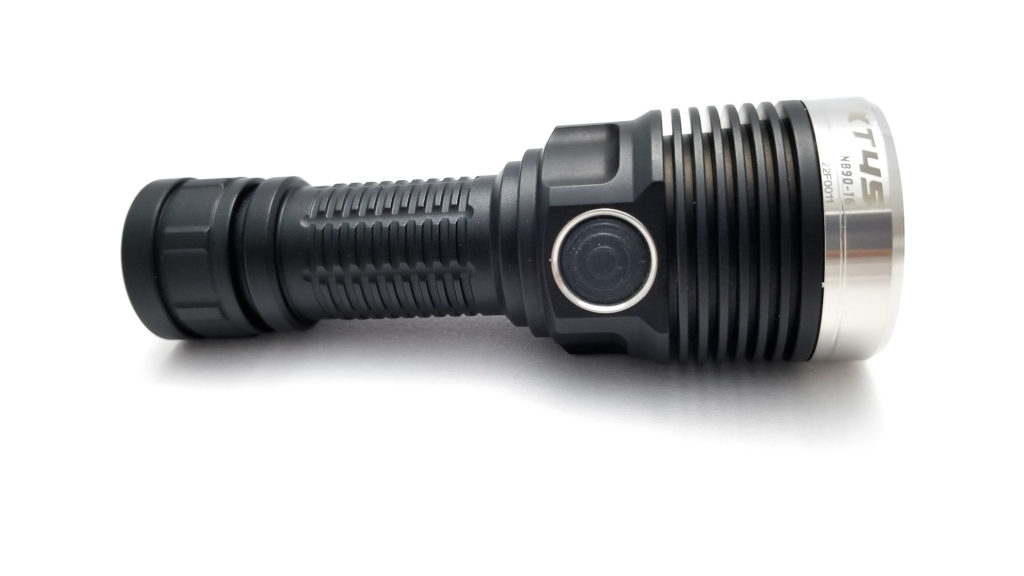
Amutorch XT45 NB90.16 specifications
| Brand/model | Amutorch XT45 NB90.16 |
|---|---|
| LED | NB90.16 |
| Max. Lumens | 10,000 lm |
| Max. Beam intensity / distance | ? |
| Battery config. | 1*21700 |
| Onboard charging | N/A |
| Modes | 4 |
| Blinkies | Strobe |
| Reflector | OP |
| Waterproof | IPX8 |
| Review date | July 2022 |
Introduction:
Amutorch is one of those slightly obscure brands that doesn’t get as much attention from enthusiasts as bigger brands like Lumintop, Astrolux, or Olight. That’s kind of unfortunate since my experience with the affordable long-throw Amutorch DM90 was positive and I found it to be a solid performer. Also known as Linyi High-tech Zone Amu Lighting Equipment Factory, they make interesting flashlights that are definitely skewed towards enthusiasts.
They’re primarily sold through Amutorchs’ website and every enthusiast’s favorite purveyor of flashlight-y goodness, Nealsgadets. A huge shout out to Neal since he sent me a couple of new-ish Amutorches to test on. Well, they aren’t really new per-se, but they are sporting a new LED. I received the smaller Amutorch XT45 and larger Amutorch XT60, so I’ll be taking a look at each in a separate review.
The subject of this review is the Amutorch XT45 NB90.16. The XT45 is a compact pocket thrower (think C8 size) and 1Lumen has tested it before in a couple of versions, one with a fresnel lens (Amutorch XT45 Fresnel) and one with an SBT90.2. However, this version takes both of those and, well, enhances them…a lot. Read on for more.
Package quality.
The XT45 NB90.16 came in a plain cardboard box, but unlike the ultra-cheap, barely adequate packing on some other lights, this one spent the extra 5 dollars for the upgraded luxo-suite. It’s more akin to something from Thrunite with a lift-off top and sturdy construction. No graphics this time, but inside there’s microcell foam cut to fit the light, and a slot for the accessories.
- Amutorch XT45 NB90.16 flashlight
- Manual (in Chinese)
- Lanyard
- Container of silicone paste
- Spare o-ring
- Rubber tactical grip ring
Overall, this is a nice surprise and is only missing a battery to be truly ready-to-use. The manual is a truncated piece of plain paper with instructions in Chinese, so Google Translate to the rescue (hint: if you have a DM90, it’s basically the same UI). The lanyard is adjustable, with a locking cinch, and including silicone o-ring grease is a very nice gesture. Thanks Amutorch.
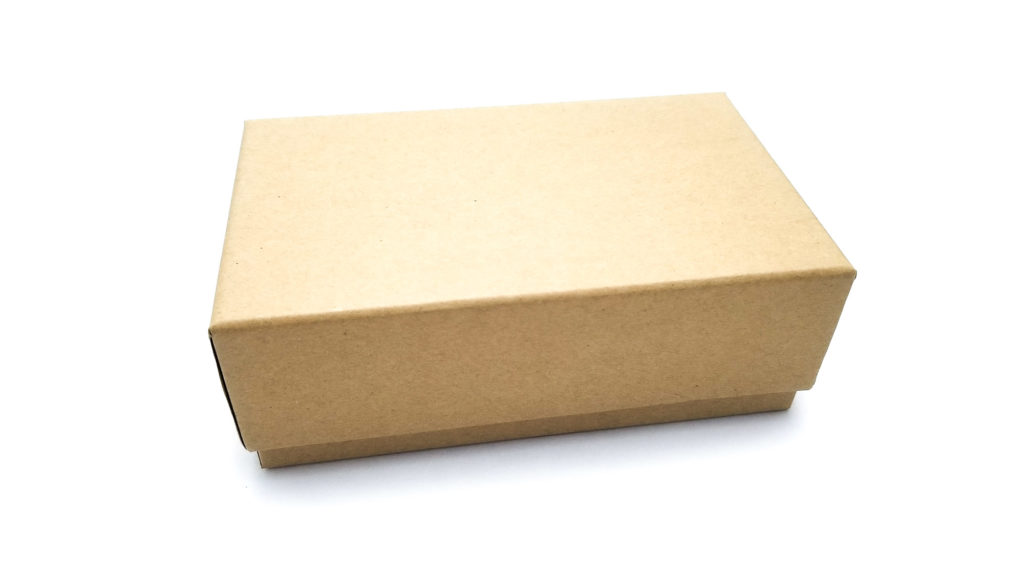
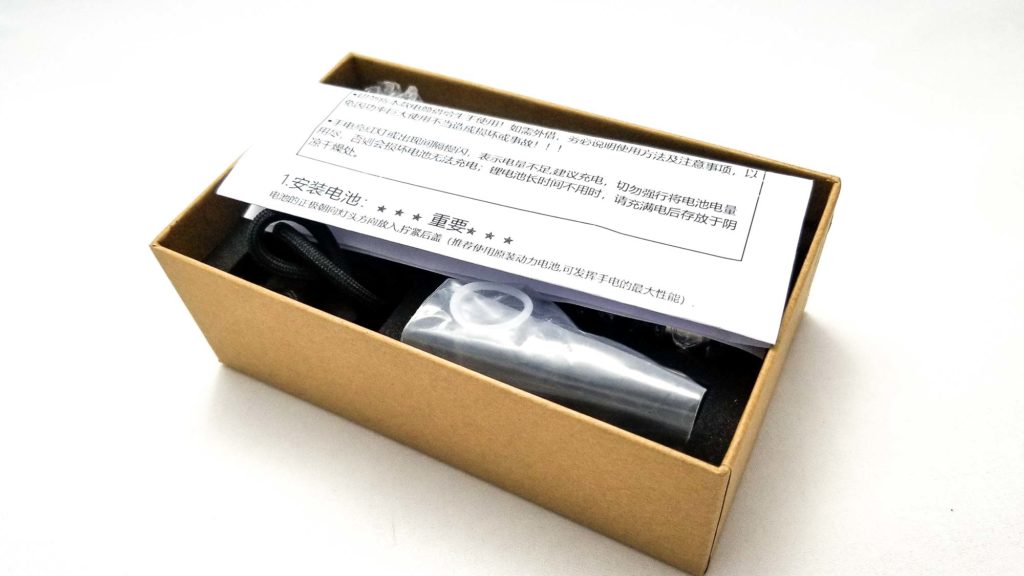
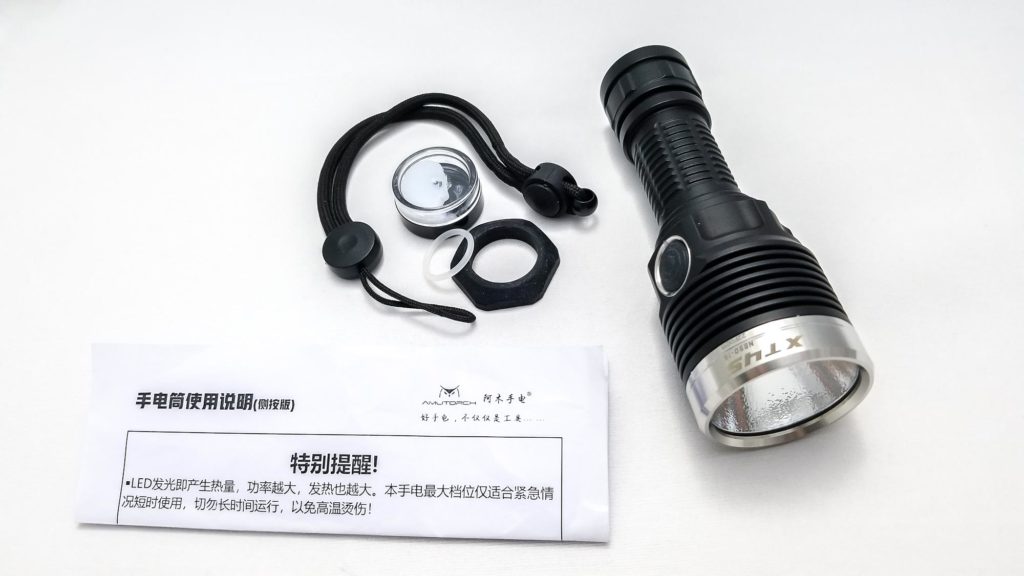
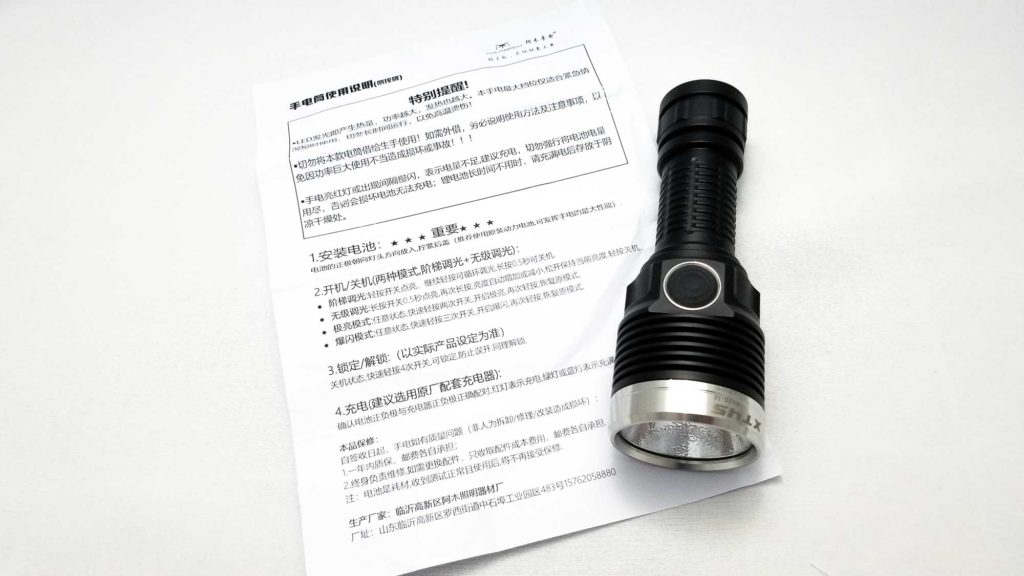
Flashlight in use
This is a compact pocket thrower flashlight, roughly compared size-wise to a standard C8 with a smaller head. It’s close in size and weight to the Astrolux EA01 as well. You’d use it anywhere a C8 would be useful: night walks, general purpose tasks (lost keys, that Cheeto that got away) etc. It’s a bit big for an EDC, but it would ride fine in a jacket or cargo pants pocket. You can affix the tactical grip ring by removing the tailcap and sliding it on, but it’s way too small, and didn’t clear the first ridge after the o-ring so the tailcap didn’t screw on all the way. That renders the light about as useful as a screen door on a submarine.
Handling is very C8-like. The 21700-size battery tube always fits my (and lots of other folks) hands nicely, with good control and positive grip in all hand positions. The light is nicely balanced as well, and seems like it should be heavier, but is pretty light. There’s a single e-switch behind the head, and it looks strikingly similar to the one used on the DM90,except the switch boot isn’t transparent, so no LVP or battery status on the XT45. The rubber boot protrudes nicely and has a stainless bezel. It’s easy to find by feel in the dark as well, but I’d like to see an indicator of some kind at least. Oh well. The clicks are nice and snappy with good feel and just the right amount of pressure to actuate the switch. Tail standing is solid, but don’t count on it to stay put on an incline since there’s no anti-roll features. You could use the tactical grip ring, but that renders the light useless. The tailcap has a couple holes for mounting the lanyard, and they’re big enough for it to pass through! Thanks Amutorch!
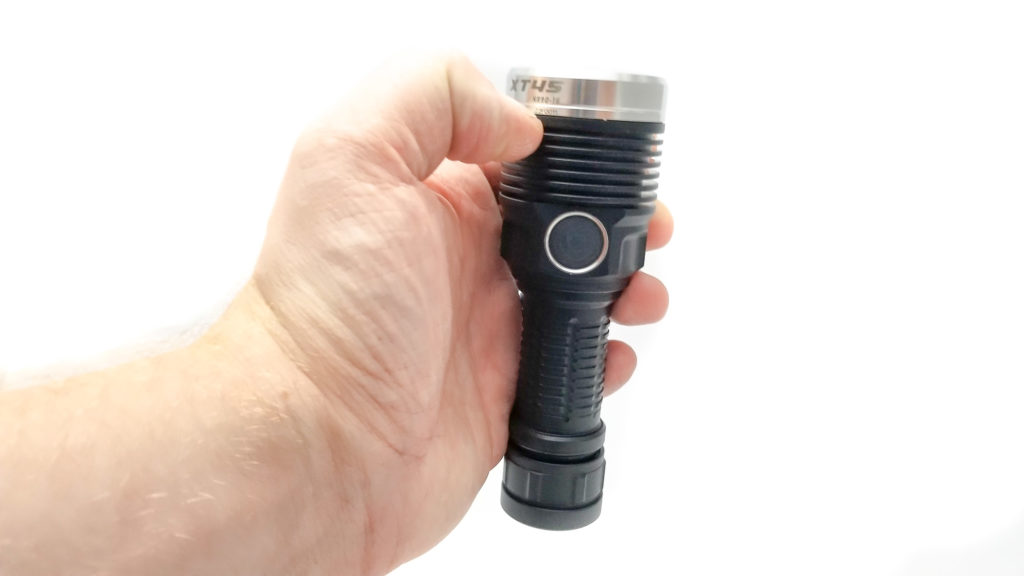
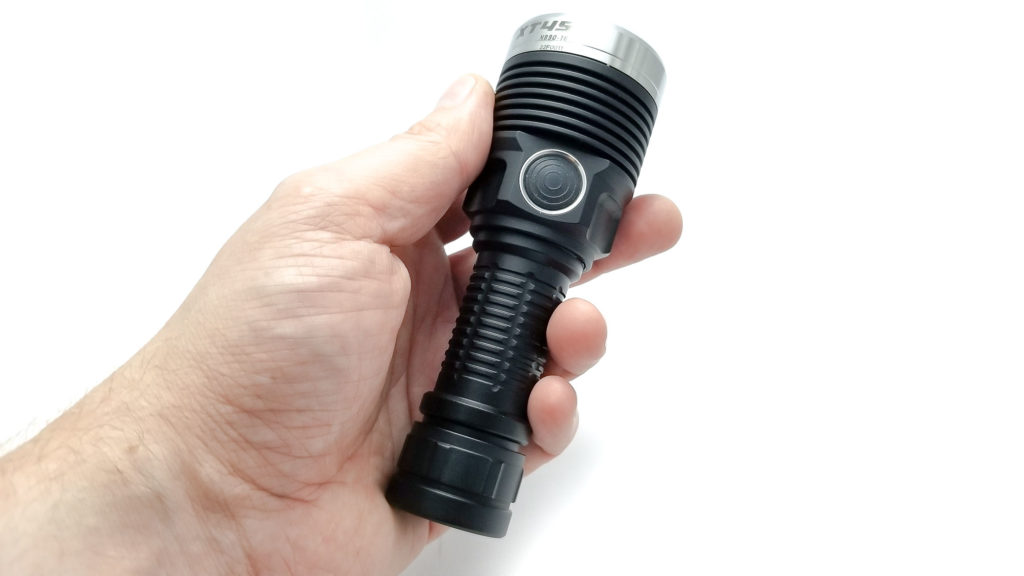
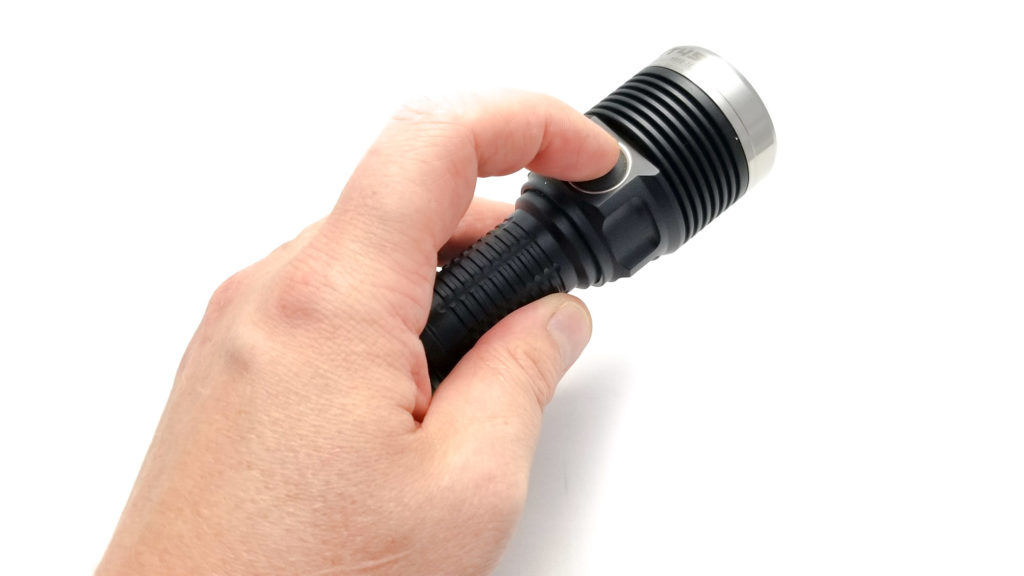
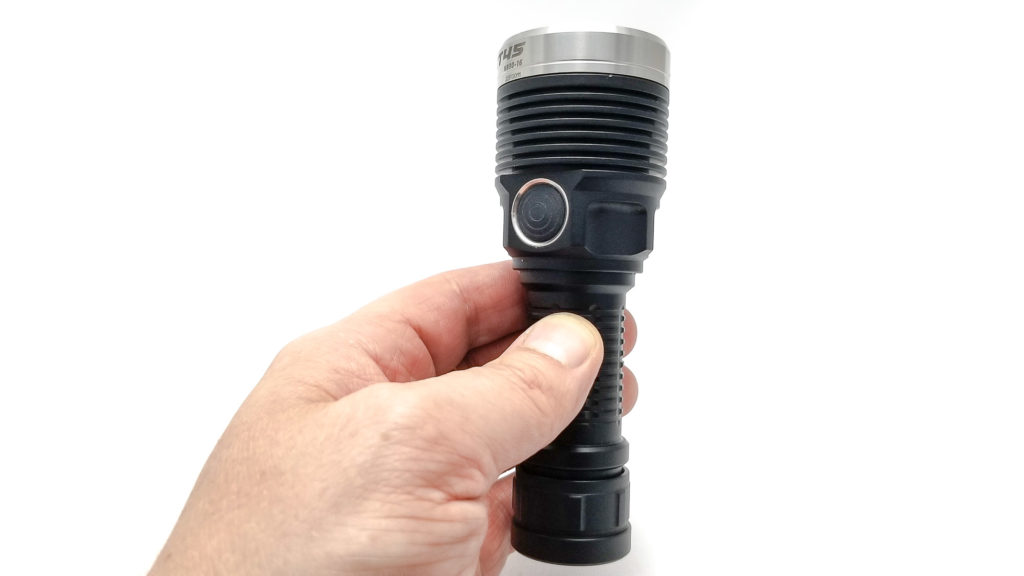
Build Quality, and Warranty
The XT45 is not Acebeam, Olight, or Fenix quality, but I’d say it’s acceptable or adequate at best. Pricing depends on the LED option, with the SBT90.2 version at the high end. The 90.16 version falls under that and sells for about $70 US, which seems a bit steep, but this is a pretty special flashlight..
The light is milled from “aeronautical aluminum alloy” so probably A6061-T6. The machining seems adequate, but overall the quality is not befitting of the price. There’s some imperfections on the bare part of the battery tube, but the rest of the machining is fine. There’s no sharp edges, and the part fit-up is good. The stainless bezel is nicely finished as well and the laser engraved text and silkscreening is sharp and precise. The finish is a nice matte black, and the anodizing is advertised as “Military regulations oxidation super-abrasion resistance.” I have no idea what that means, but unfortunately, it’s not very well done, with the raw aluminum showing through on the head in a couple places. The tailcap seemed to have a different finish of black, and the light had what looked like splotches of errant sealant or something in random places. I cleaned them up with isopropyl alcohol, but there’s still an obvious difference between the tailcap’s shade of black, and the rest of the body. In fact, the areas in between the heatsink fins, and the battery tube are noticeably blacker, which is disappointing, and the LED is not centered in the reflector.
On the plus side, you can completely disassemble the light. unscrewing the bezel gives access to that humongous LED. The threads on both ends of the battery tube are sturdy, fully anodized rectangular cut units, and while not the smoothest or most-lubed I’ve encountered, were…adequately smooth. There’s two o-rings sealing the battery tube, one sealing the bezel, and one behind the lens, and minus an external charge port, this all adds up to IPX8 ingress-resistance, so waterproof to 2 meters depth. Scary! There’s a fairly thick single spring press-fit into the tailcap. It’s supposedly a high-current BeCu spring, and it is nonmagnetic. It needs to be to handle the huge current this will pull.
Warranty? From Amutorch.com:1 year warranty–AMUTORCH offers free warranty work if the problem is caused by normal usage within 1 year after receipt. Lifetime warranty – For the life of your light, repairs will be made with no labor chargers and as long as parts are available from AMUTORCH. You will be charged for the parts needed to repair your light. Following situations are excluded from warranty–Damage caused by unproper disassemblement, modification and unproper usage is excluded from warranty. Battery is excluded from warranty. If the battery doesn’t work upon receipt, it could be replaced. Accessories come along with flashlight such as lanyards, bag, o-ring, etc. are not covered by the warranty. Not the greatest or most robust, but it will get you down the road.
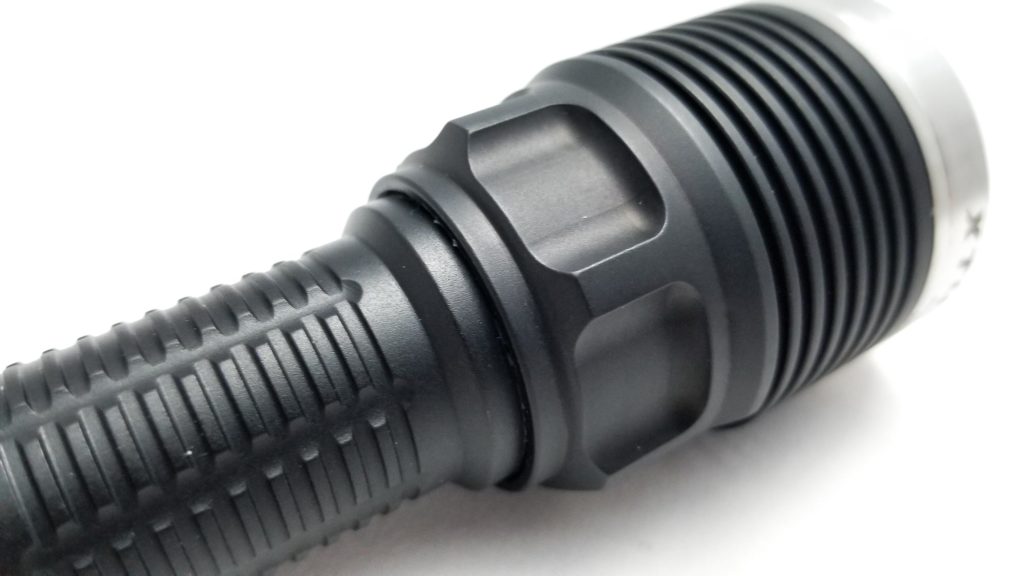
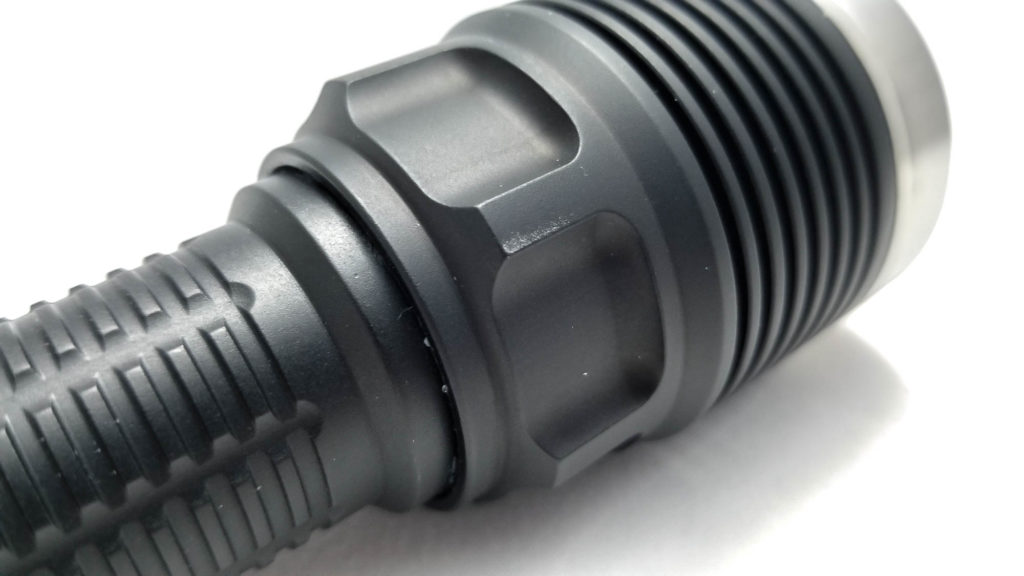
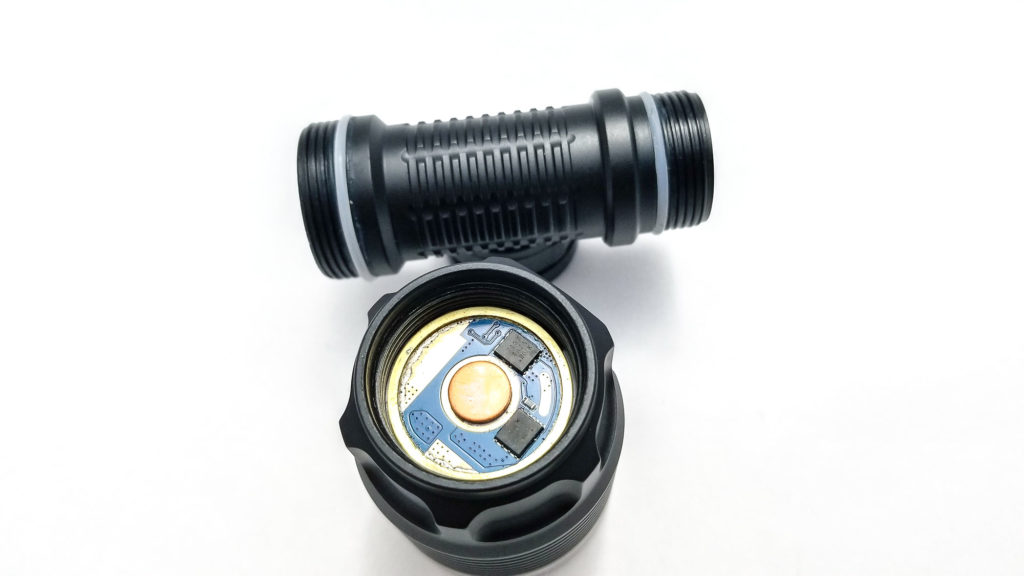
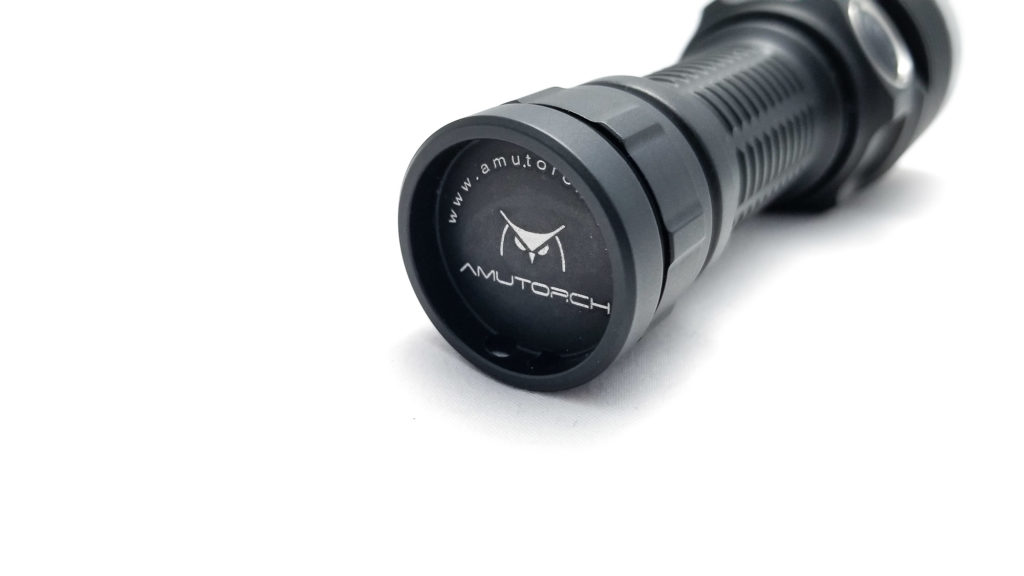
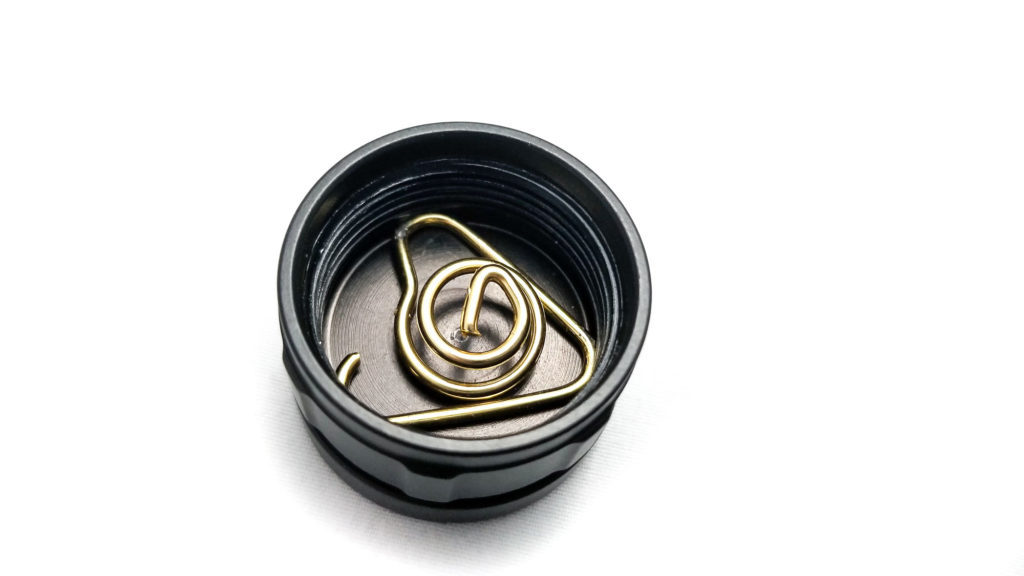
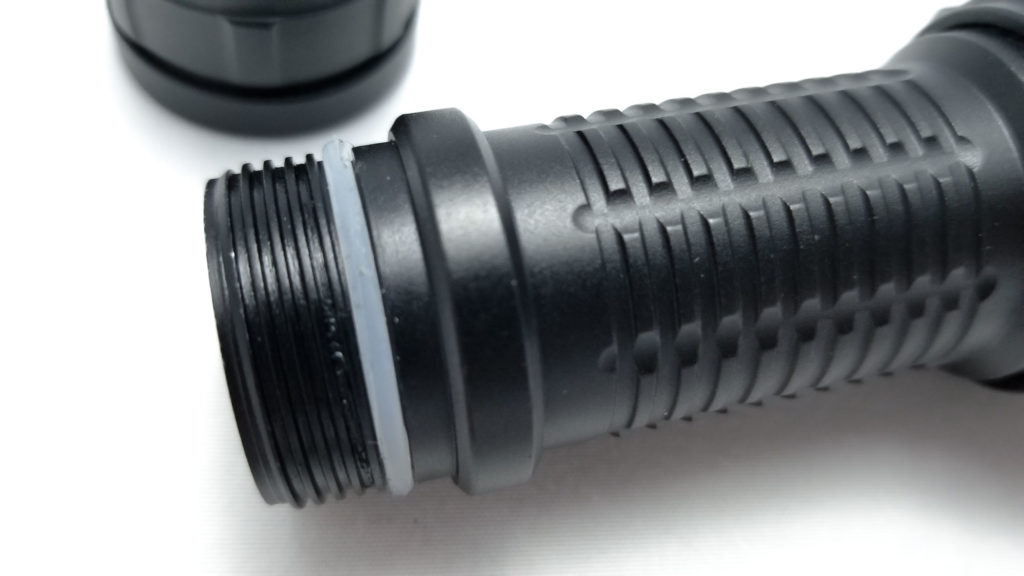
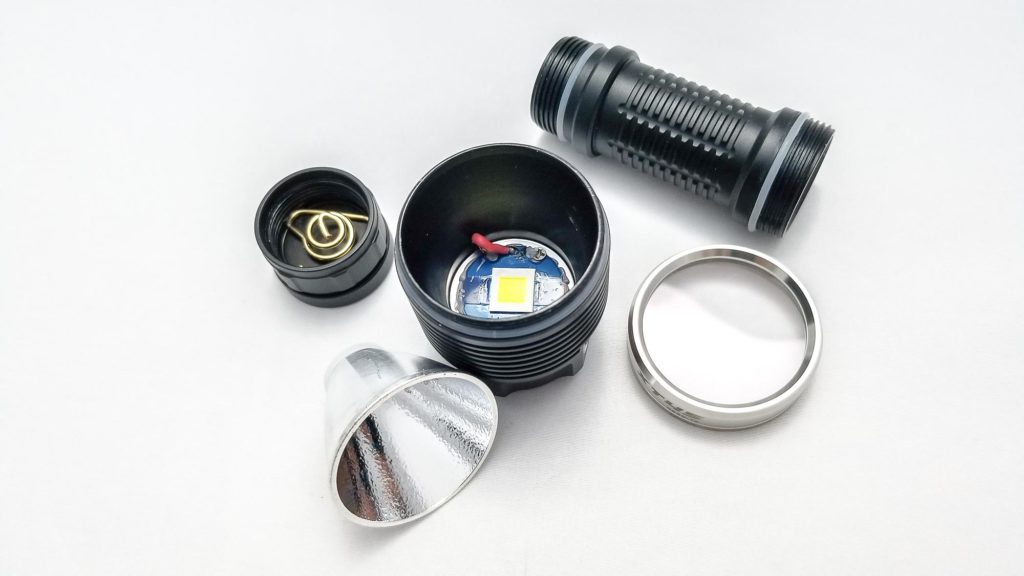
LED, Lens, Bezel, Beam, and Reflector
Amutorch makes 5 versions of this light (availability, however, varies): One with an XHP50.3 HI, XHP70.2, the NB90.16 version, one with the YinDing 5050 LED and fresnel lens, and an SBT90.2 version. The test light features the mysterious NB90.16 LED. I say mysterious because there’s no data sheets, no specs, nada. However, it bears a striking resemblance to the more familiar SFH55 LED. This is a domeless, 11×11 mm footprint LED, the same as the SBT90.2. It’s a 3-volt LED, so it will fit on SBT90.2 MCPCBs without modification.
Like the 7070-size SFN55.2 LED I tested in the Lumintop D3 and Nightwatch NI03 Valkyrie, the LES is made up of 16 individual dies strung together on a single substrate in a 4×4 pattern arranged symmetrically in the CSP configuration. With a low Vf compared to other big emitters, this LED can purportedly make 14,000 Lumens at something like 60+ amps! The tint is cool white, and no CCT is specified. The Opple Lightmaster Pro has the tint coming in at 7534K and 71.6 Ra with a duv of -0.0033, so below the BBL and about what I expected. I think the green AR coating on the lens is helping out here.
The reflector is a 45 mm wide OP (textured) reflector. It’s sort of shallow (shallower than a C8 reflector), and has a 11 mm wide opening at the base for the huge NB90.16 LED. A thin gasket isolates the LED from the reflector, but provides zero centering for it (and it’s off-center a bit). The lens is a hardened mineral glass unit with a nice green AR coating, which should bring down the duv a bit since these SF* LEDs tend to be a bit green at low currents. The bezel is a very nicely finished polished 304 stainless unit. No crenulations this time, but the lens is set back a good 4 mm for protection from drops. The beam consists of a nicely diffuse very large hotspot surrounded by bright spill. The OP reflector does a good job of smoothing out any irregularities caused by the non-homogenous LES, and the tint distribution is very good with minimal corona and no artifacts in the beam.

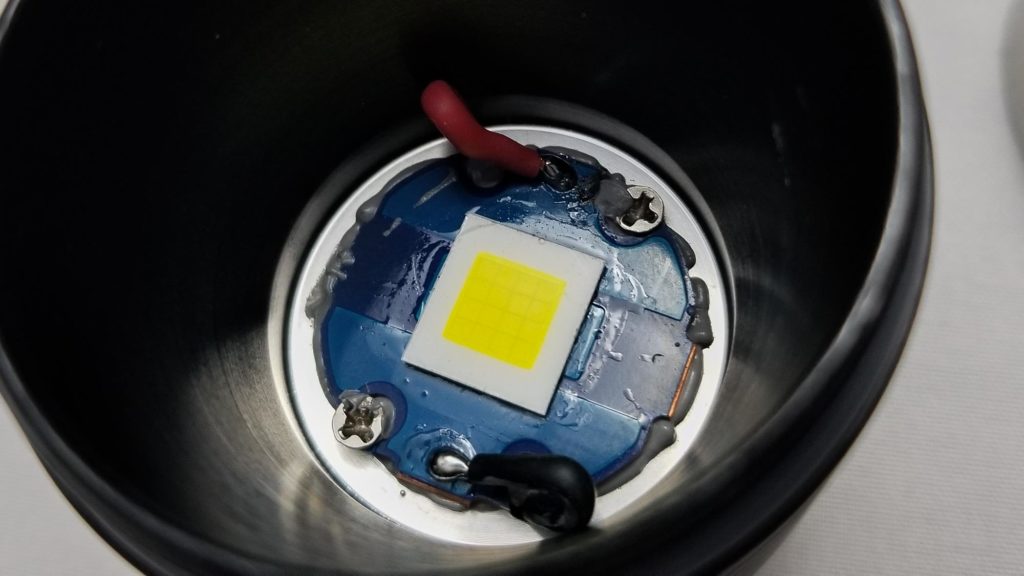

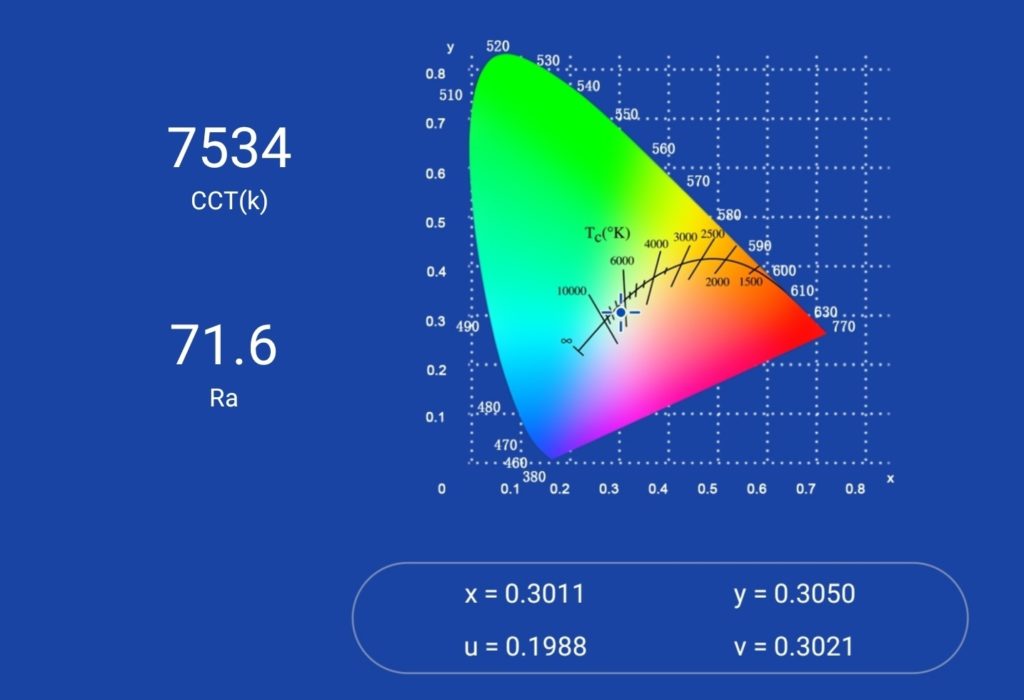
Dimensions and size comparison
Dimensions:
| Amutorch XT45 NB90 Dimension | Millimeters | Inches |
|---|---|---|
| Length | 130 | 5.11 |
| Head diameter | 45 | 1.77 |
| Body diameter | 26 | 1.02 |
Weight:
| Amutorch XT45 NB90 Weight | Grams | Oz. |
|---|---|---|
| Without battery: | 165 | 6 |
| With Molicel P42A 21700: | 235 | 8.3 |
Flashlight comparison
Group 1 left to right: Nightwatch NI03 Valkyrie, Amutorch XT60 NB90.16, Amutorch XT45 NB90.16, Lumintop D3
Group 2 left to right: Amutorch XT60 NB90.16, Amutorch DM90, Amutorch XT45 NB90.16
Group 3 left to right: Amutorch XT45 NB90.16, Imalent R30C, Thorfire C8
Group 4 top to bottom: Amutorch XT60 NB90.16, Amutorch XT45 NB90.16

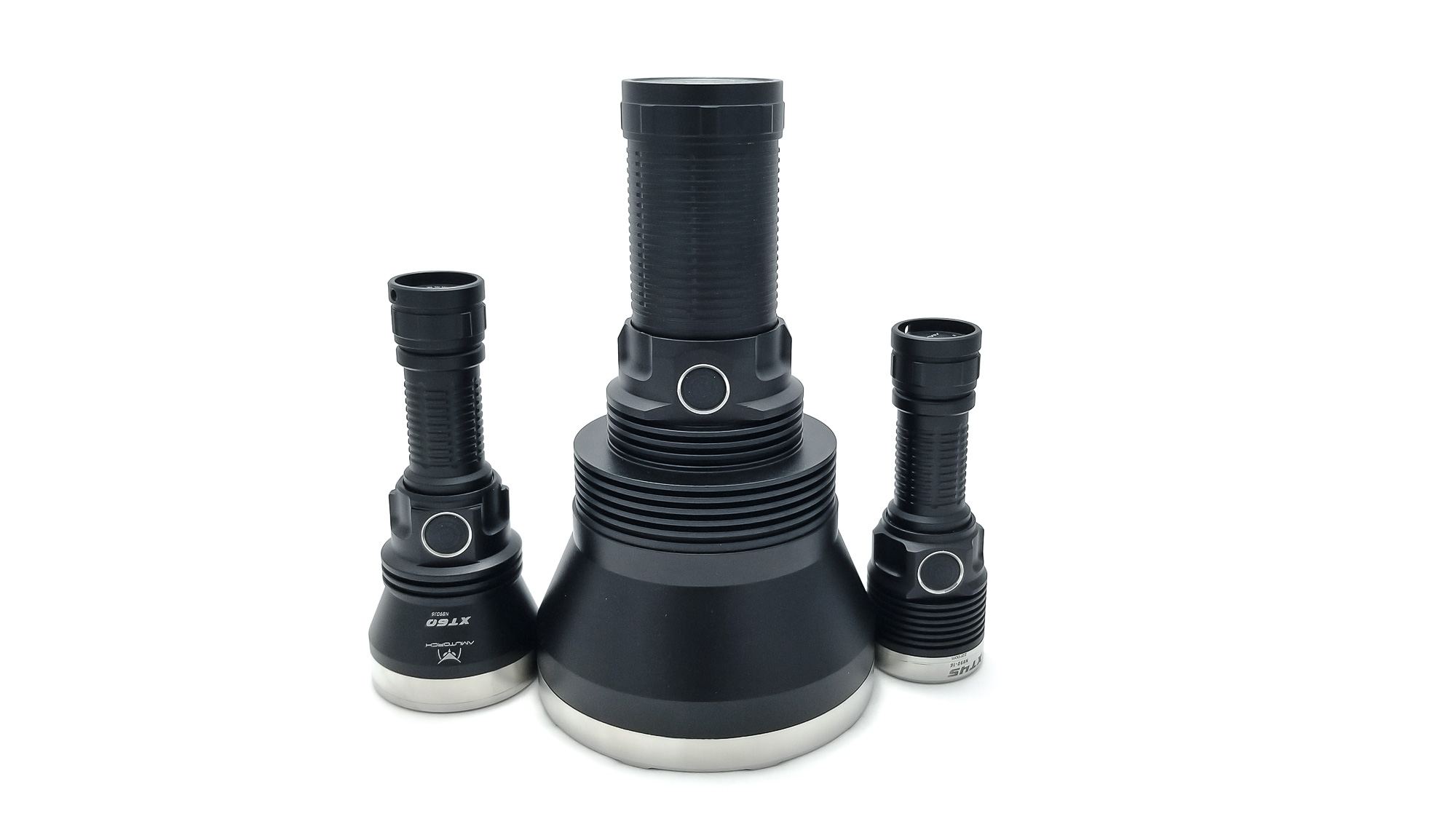
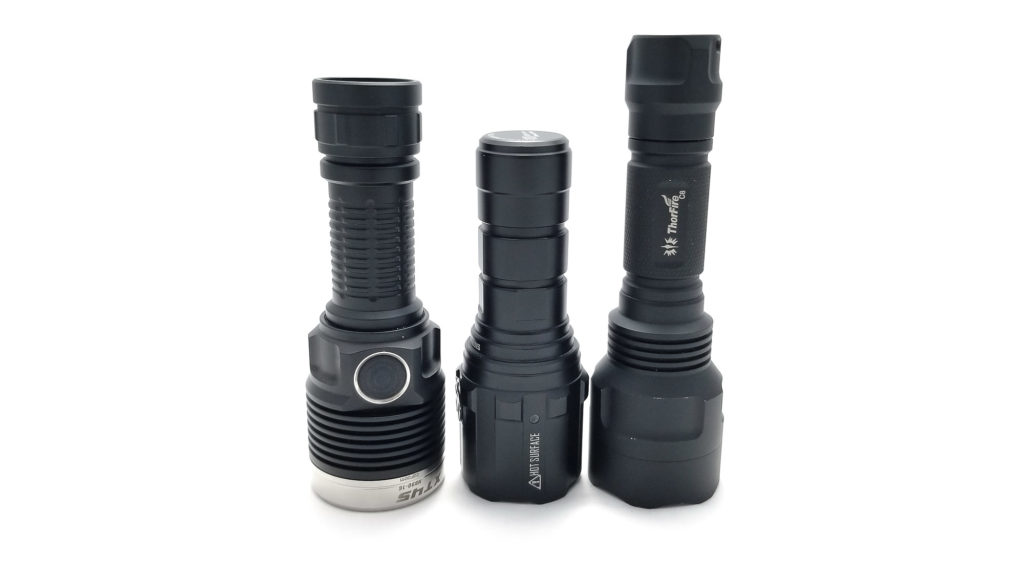
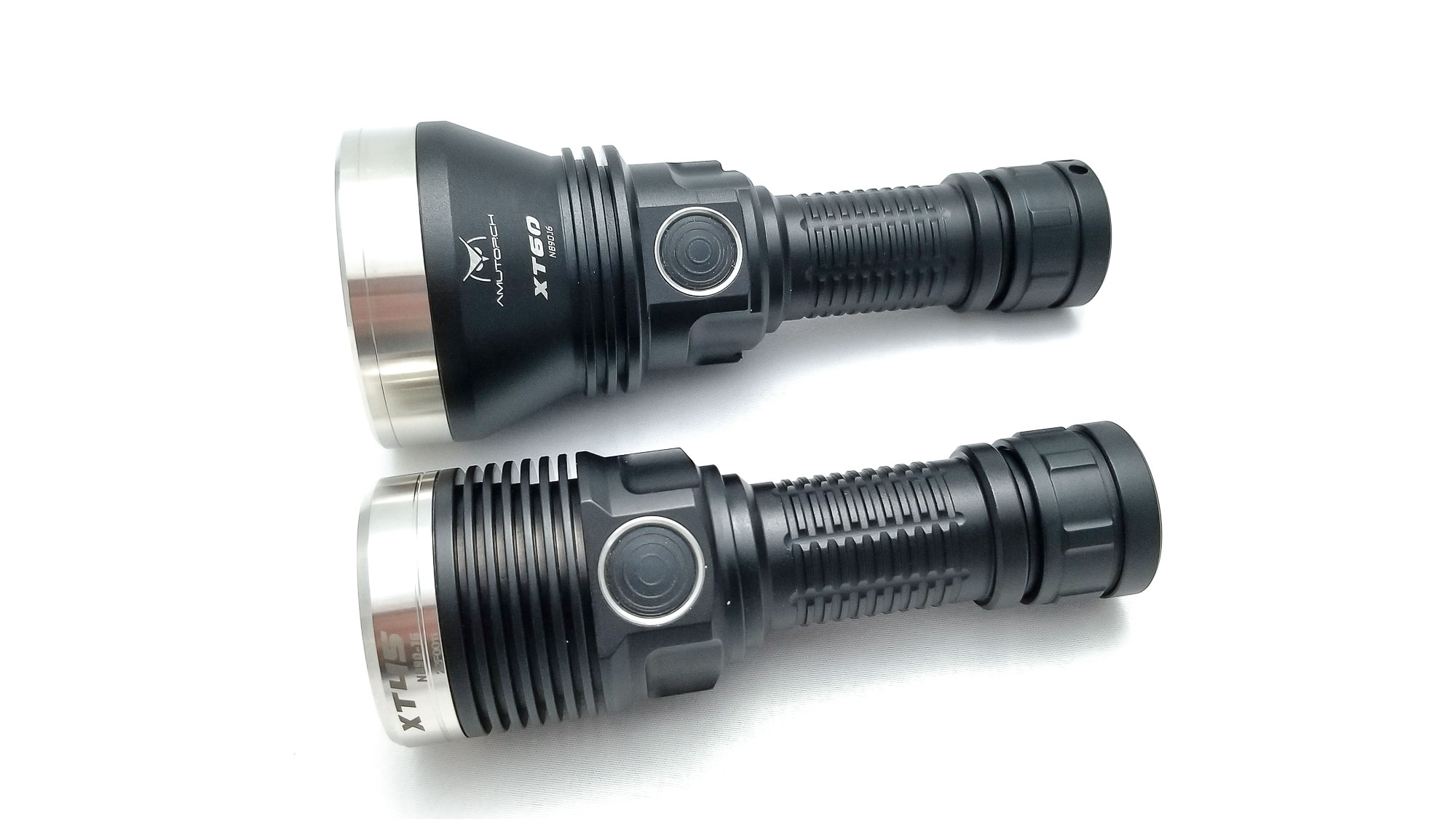
Driver & User Interface:
I don’t know what kind of driver is hiding behind the head, but it looks like a dual-sided board with a copper button in place of a spring on the positive end.
The UI has been borrowed from the Amutorch DM90, and it’s a serviceable UI with 4 modes and a single hidden Strobe. There is a smooth ramping function, accessed from on or off by pressing and holding the switch, but it’s a bit quirky and weirdly-implemented.
Available modes (Default):
- Low, Mid, High Turbo,
Blinky modes:
- Strobe, with optional, semi-hidden Smooth Ramping
From OFF:
- Single click: Turns on in Stepped Ramp Mode
- Click and hold: Turns on in Smooth Ramp Mode
- Double click: Turbo
- Triple click: Strobe
From ON:
- Single click In Smooth Ramp Mode: Turns off
- Single click In Stepped Ramp Mode: Changes modes L-M-H-L
- Click and hold In Stepped Ramp Mode: Ramps brightness up. Releasing and pressing and holding again ramps down.
- Double click: Turbo
- Triple click: Strobe
Mode memory
- Yes, and each mode set has its own memory, and each starts in its respective last mode when activated. Turbo and Strobe are not memorized.
Shortcuts:
- Double click for Turbo
- Triple click for Strobe
Low voltage warning:
- ?
Strobe/blinkies
- Strobe
Lock-out mode:
- Yes, electronic lockout accessed by 5 clicks from off. The light will blink in a very low mode when the switch is pressed. Repeat to unlock. The light will blink to acknowledge.
PWM
- None!
Additional info on the UI: Okay, the mode spacing is borderline ludicrous: There is no Low mode, and High to Turbo is an 8600 Lumen difference. The ramping, while it’s not terrible, could benefit from some refinement, especially in the ramp speed. It only works when activating the light from off, and the ramping is a bit slow going. From bottom to top of the ramp takes a whole 5.5 seconds. Anduril takes about 3.4 seconds, and it isn’t very linear.
The ramp top and bottom are indicated by a slow double blink. Also, it seems like the ramp mode and stepped mode memories don’t commingle. It will start in whatever mode was last used when you used the smooth ramping or the stepped ramping mode. Starting in a stepped mode will default to the last-used stepped mode, and vice versa with the smooth ramping. I think this could be good or bad, but a nice feature. There’s no LVP specified, and the switch doesn’t have the indicator LED the DM90 had. We’ll see how it goes in the runtime test.
Batteries & Charging
The XT series are designed around a single 21700 lithium-ion cell. No battery was included with the light, although Neal and Amutorch offers them (and a charger) as an add-on. There’s no onboard charging either, so you will need a li-ion charger. For batteries, you’re pretty much limited to flat or button top unprotected batteries. I tried some long 21700s with protection circuits and they were way too long. Protected batteries would work, but Turbo would be inaccessible. You’re going to need a high CDR battery for this light, one that can do at least 30-40 amps, so Samsung 40T, 30T, Sony VT6A, and Molicel P42A. You could use a lower-CDR battery, but Turbo output will be significantly reduced.

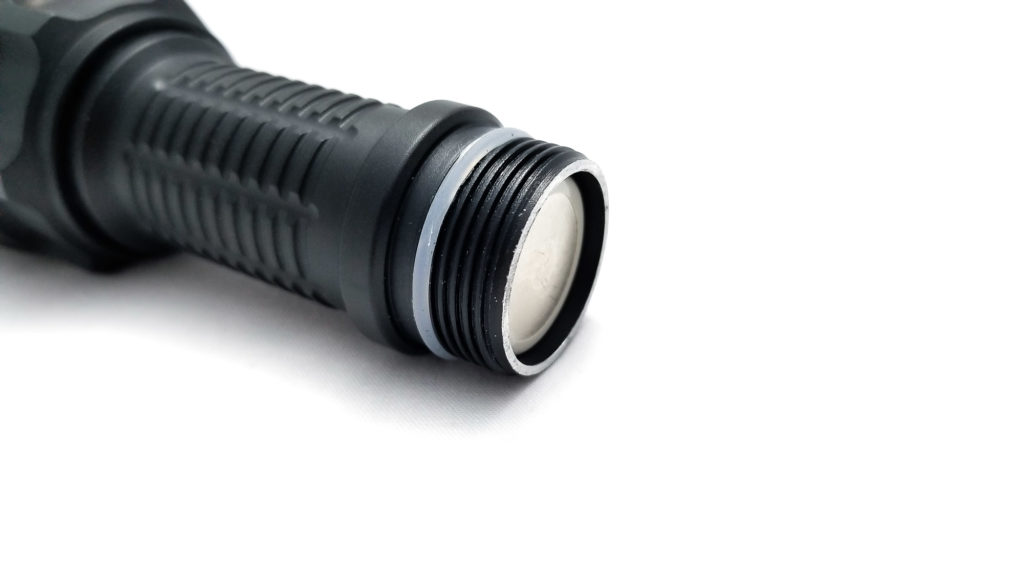
Performance test
Lumen measurements:
Lumens are measured using my home made 50 cm integrating sphere, and I use a Digi-Sense 20250-00 datalogging luxmeter. The sphere has been calibrated using many lights of known output and is accurate within 10% of actual output. All measurements taken at 30 seconds using a fully charged Samsung 30T 3000 mAh battery. Amps were measured with my Radioshack T-RMS multimeter with 14 gauge wires in the meter and higher currents with my FY219 clamp meter and a loop of 12 gauge wire.
| Mode | Amps at Start | Specs | turn on | 30 sec | 10 minutes |
|---|---|---|---|---|---|
| Low | 480 mA | 420 | 330 lm | 330 lm | – |
| Medium | 960 mA | 760 | 747 lm | 730 lm | 730 lm |
| High | 2.9 A | 2000 | 1892 lm | 1876 lm | 184 lm |
| Turbo | 32 A | 10,600 lm | 9960 lm | 1494 lm | 996 lm |
That NB90.16 LED is a powerful brute. Although it’s not technically a single LED, 32 A is a lot for a small host (almost 100 watts). Thankfully, the lower modes are more practical.
Parasitic drain:
- 2.1 µA
Runtime graph
Runtimes were measured in my home made 50 cm integrating sphere. I use a Digi-Sense 20250-00 datalogging luxmeter. The sphere has been calibrated with many lights of known output and is within 10% of actual output. I used a Molicel P42A 4200 mAh battery for each test. I tested Medium, High, and Turbo modes.

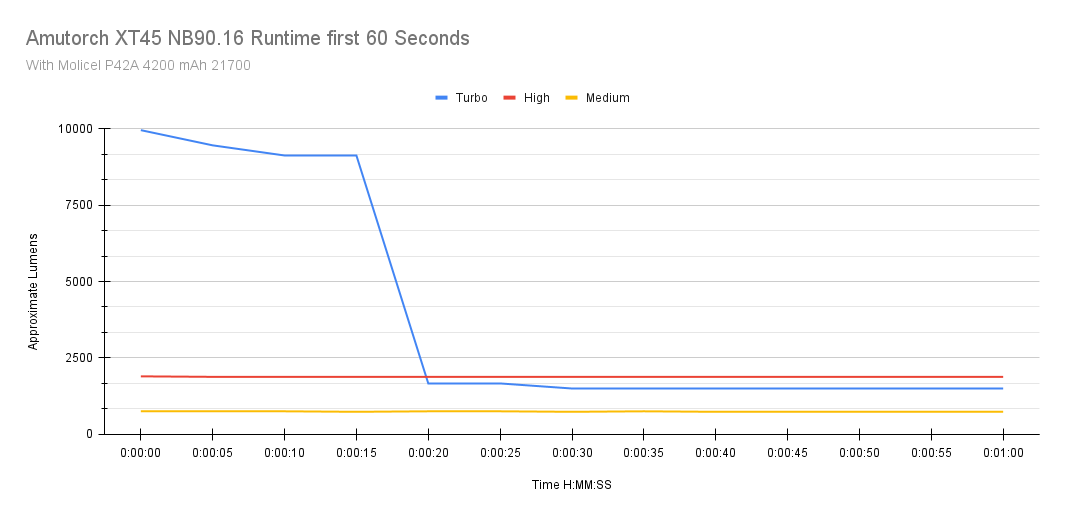

| Mode | Specified | Measured runtime (ANSI) | Time till shut off |
|---|---|---|---|
| Low | 7h 40min | – | – |
| Medium | 3h 30min | 3h 28min | 3h 28min |
| High | 1h 10min | 1h 10min | 1h 10min |
| Turbo* | >1h | 6m 40s | 1h 49min |
What’s this? It appears that Amutorch’s factory runtime specs are dead on (at least by my testing) and that’s pretty fantastic. Also, there’s a fully regulated driver at work here. Very nice! Amutorch says Turbo is supposed to step down to High mode, but the graph shows it’s a bit less than that. Still, we’re maintaining over 1300 Lumens for a good long while, and 1000 Lumens for a long time. The Turbo stepdown is thermally regulated and seems to happen around 55 or 60 C, which comes and goes very fast (about 25 seconds, and the head is very hot), but it can be reactivated at any time. High and Medium both give usable amounts of light for a long time. The light never went over 65 C during the testing, and the Medium mode stayed at or under 50 C. The shut down is abrupt, but the light does give visual warning before LVP pulls the plug. A nice surprise with these runtimes for sure. The battery was discharged to 3.0 to 2.8 volts each time.
ANSI FL1 standards: The runtime is measured until the light drops to 10% of its initial output (30 seconds after turning on). This does not mean that the flashlight is not usable anymore. The last column shows how long the light actually works till it shuts off. If there is a + symbol, it means that the test was stopped at that particular point, but the light was actually still running. This happens on certain occasions, with certain drivers, firmware, or batteries.
Throw numbers: Peak beam intensity
Throw was measured indoors at 5 meters using the Uni-T UT383S luxmeter. Measurements taken at 30 seconds. I used a fully charged Samsung 30T 3000 mAh battery for this test.
| Mode | Specs | Candela measured | Meters | Yards |
|---|---|---|---|---|
| Low | ? | 2900 | 108 | 118 |
| Medium | ? | 5625 | 150 | 164 |
| High | ? | 14,675 | 242 | 265 |
| Turbo | ? | 12,875 (80,050 at start) | 227(566 at start) | 248(619 at start) |
Amutorch only lists a single throw measurement, 593 meters, probably the Turbo figure. I obviously got a lot less because the stepdown happens at or before the 30 second mark. On startup, I got 80,050 cd for 565.8 meters of throw. Not too shabby for a huge LED.
Extra info: Peak beam distance according to ANSI FL1 standards: The calculated value of distance in meters at which the flashlight produces a light intensity of 0.25 lux. (0.25 lux is about the brightness of a full moon shining on an object).
Beamshots
I compared the XT45 NB90.16 to some other high-output lights,
- Amutorch XT60 NB90.16
- Thrunite TN50
- Sofirn SP36 Pro
- Astrolux MF01 Mini
- Nightwatch NI03 Valkyrie
- Lumintop D3
- Astrolux FT02S
- Imalent R30C.
The fence is 40 meters distant.
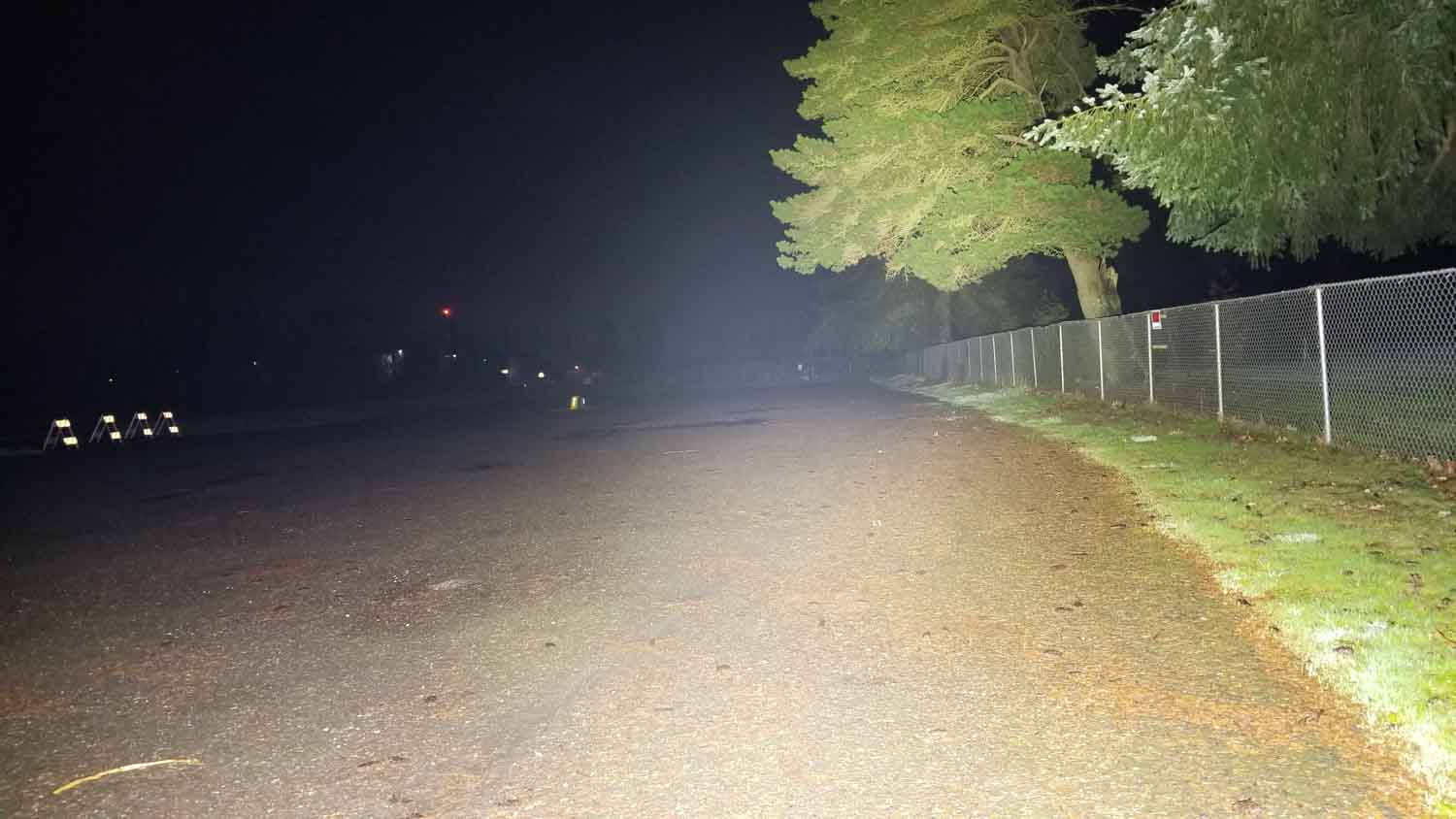
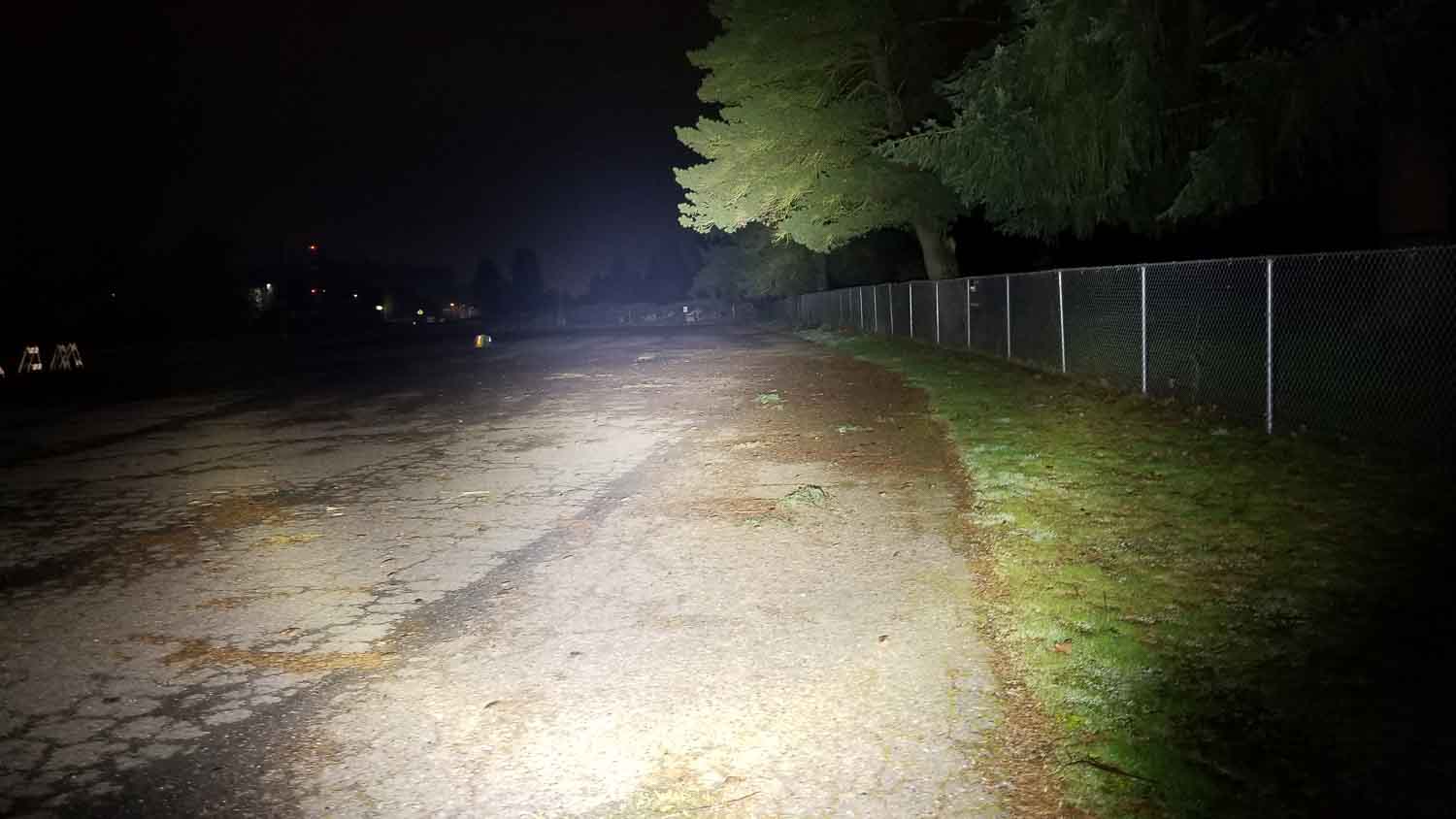
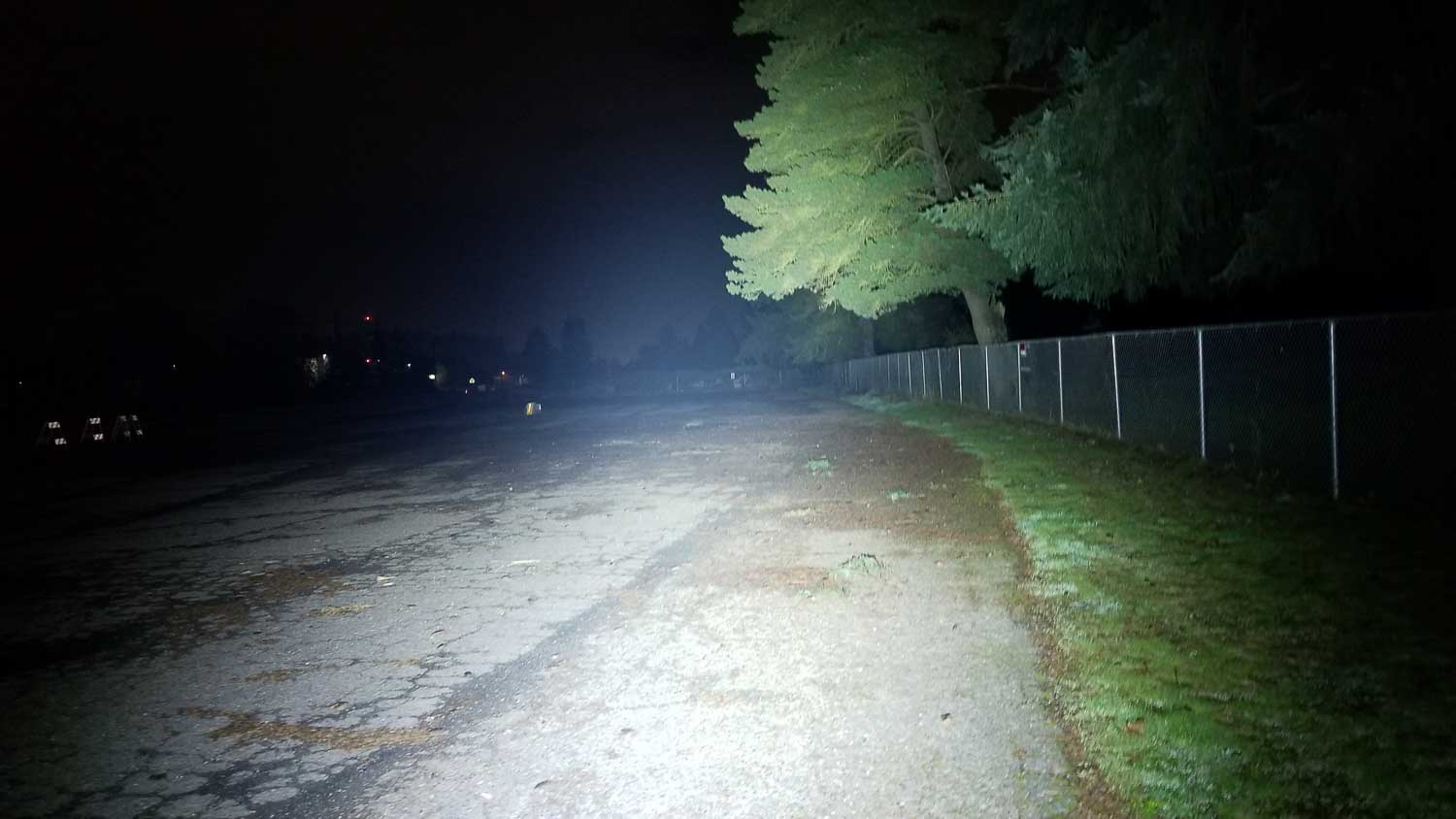
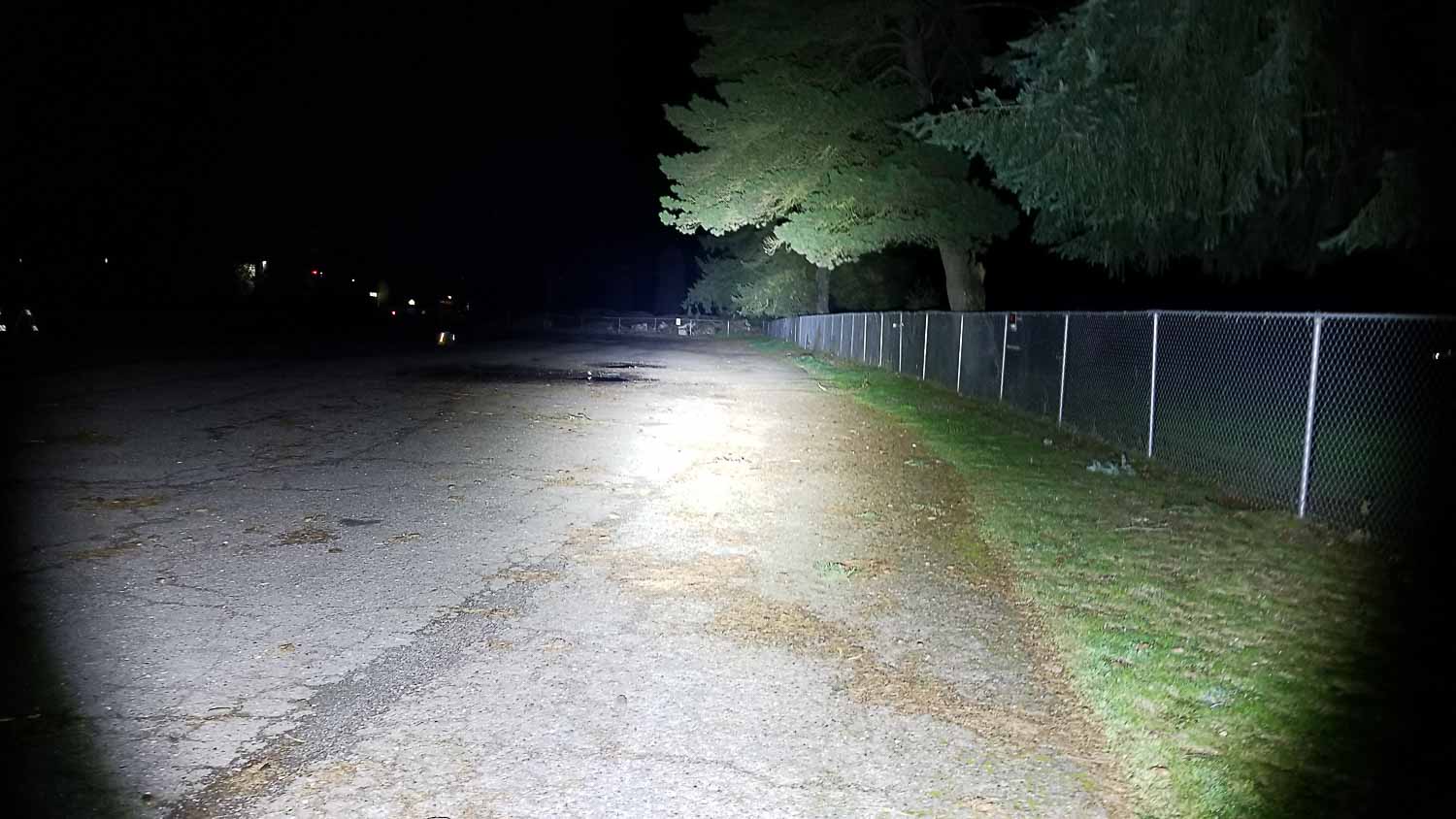
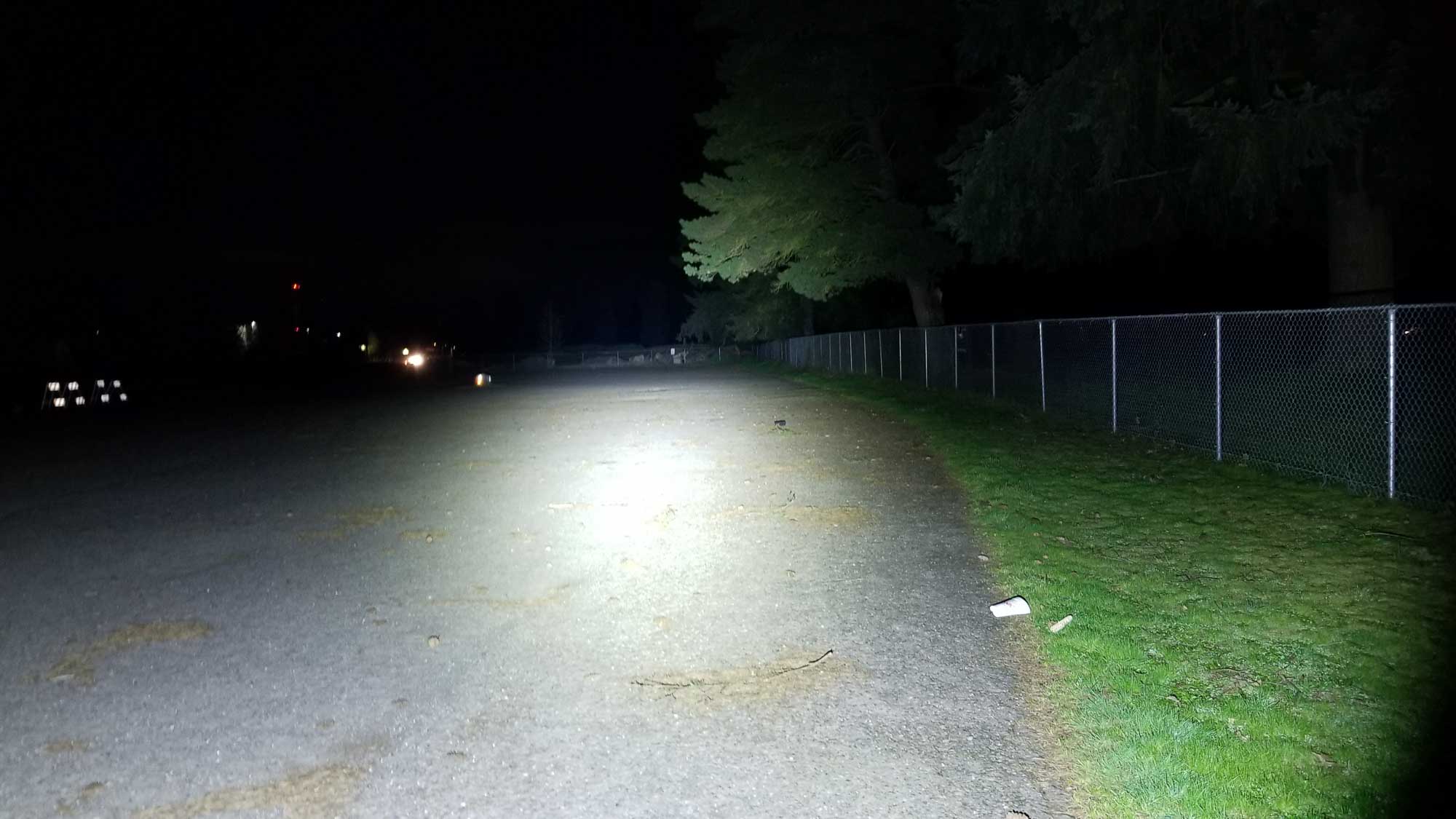
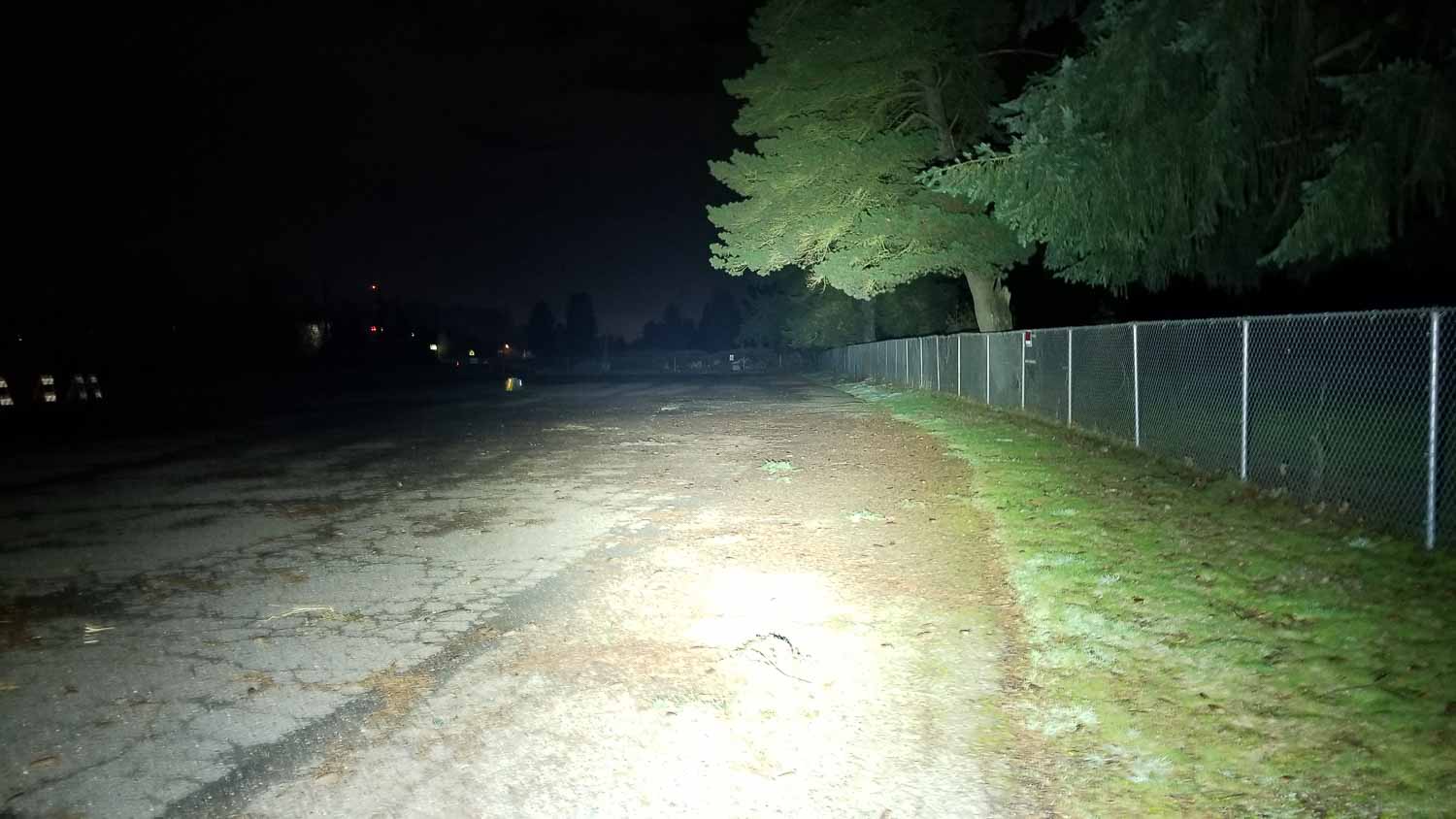

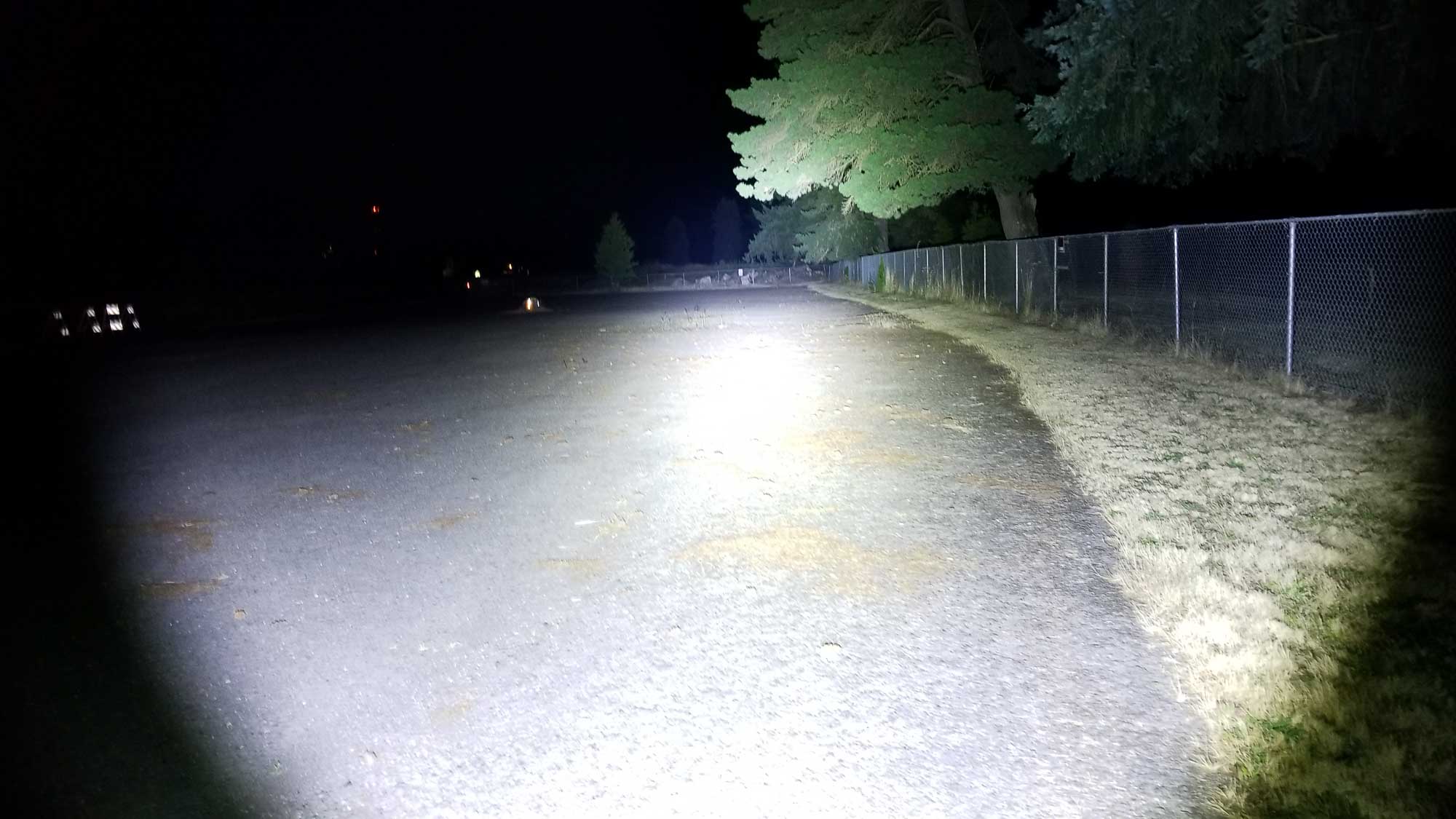
Disclaimer: This flashlight was sent to me for review at no cost by Nealsgadgets. I have not been paid to review, nor have I been holding back on problems or defects.
Final Verdict
Pros
- Huge output in a small package
- Simple UI
- Nice beam and throw
- Compact and lightweight
- Decent build quality
- All modes are fully regulated
- Great sustainability for a small host
Cons
- Fast step down on Turbo
- Quality issues
- No onboard charging?
- Smooth ramping needs refining
Explanation on star ratings:
1: Avoid: my phone flashlight would be a better choice – 2: Poor: significant defect or issues; almost unusable – 3: Average: some defects or issues; but still usable 4: Good: recommended (minor issues) – 5: Great: highly recommended

4 stars: ★★★★
Throughout history, humanity has been pushing the envelope with just about everything: Cars, motorcycles, physical fitness, and even the laws of physics. It was only a matter of time before this phenomena found its way into the flashlight camp. The result? More advanced LEDs, higher capacity batteries, better optics, efficient drivers and custom firmware. You might be asking how the Amutorch XT45 NB90.16 fits in here. Well, take a C8-size host, jam in a very high performance LED, give it a nice driver, and voila! A sleeper flashlight that will happily help you find a lost Lego, but also throw 10,000 Lumens over 500 meters (albeit briefly).
Lights like the Amutorch XT45 NB90.16 (and XT60) are why I do this. It’s awesome to see companies pushing the envelope and trying outlandish and somewhat impractical (but oh so cool) lights. The XT45 NB90.16 is well-built and solid with good machining, high current spring in the tail, and a decent switch. The performance is pretty incredible for such a small flashlight, and the fully regulated driver is a huge bonus and enhances the usefulness quite a lot. I like the compact pocketable size and lightweight as well. Alas, it’s not perfect though and the finishing and quality control SNAFUs are a bit unacceptable in a $70 light. The UI, while serviceable and usable, is better left in the stepped ramping mode. The Low mode…isn’t, and while I love the crazy Turbo output, it’s so short-lived. I’m not too at arms about not having onboard charging, but it’s a nice convenience feature I miss. Overall, if you can live with the eccentricities, the Amutorch XT45 NB90.16 edition is a unique and versatile light. I’m giving it 4 stars mostly due to the quality issues. Still, it really is a diamond in the rough, and if pocket rockets are your thing, give this a look.
Amutorch XT45 NB90.16 discount code
Get 15% off: 1lumen711
For newly listed lights: 25% off with: 1LumenNEW
1lumen selects and reviews products personally. We may earn affiliate commissions through our links, which help support our testing.